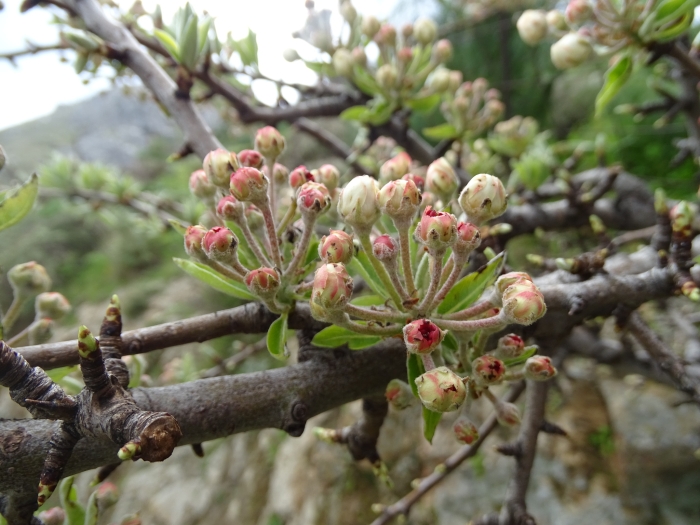Almond-Leaved Pear
(Pyrus spinosa)
Almond-Leaved Pear (Pyrus spinosa)
/
/

© Grzegorz Grzejszczak
CC BY-SA 4.0
Image By:
© Grzegorz Grzejszczak
Recorded By:
Copyright:
CC BY-SA 4.0
Copyright Notice:
Photo by: © Grzegorz Grzejszczak | License Type: CC BY-SA 4.0 | License URL: http://creativecommons.org/licenses/by-sa/4.0/ | Uploader: grzegorz_grzejszczak | Publisher: iNaturalist |






















Estimated Native Range
Summary
Pyrus spinosa, commonly known as almond-leaved pear, is a deciduous small tree or large shrub native to rocky hills and scrub areas in the northern Mediterranean region, including Southern Europe and Western Asia. It typically grows to a height of 10-33 feet (3-10 meters) and is characterized by its narrow, almond-like leaves. The almond-leaved pear produces showy white flowers in April and May, which are followed by small, hard, and bitter fruits that are usually not consumed by humans but can serve as a food source for wildlife. The bark is often dark and scaly, adding to its ornamental value.
The almond-leaved pear is valued for its drought tolerance and ability to thrive in poor, rocky soils, making it suitable for xeriscaping and naturalistic plantings. It is often used in ornamental gardens for its spring blossoms and as a specimen plant in dry, Mediterranean-style landscapes. While it requires minimal maintenance once established, it does best in full sun to part shade and prefers well-drained soils. Gardeners should be aware that this species can hybridize with other pear species, which may be undesirable for those seeking to maintain species purity. Additionally, it can be susceptible to common pear diseases such as fire blight.CC BY-SA 4.0
The almond-leaved pear is valued for its drought tolerance and ability to thrive in poor, rocky soils, making it suitable for xeriscaping and naturalistic plantings. It is often used in ornamental gardens for its spring blossoms and as a specimen plant in dry, Mediterranean-style landscapes. While it requires minimal maintenance once established, it does best in full sun to part shade and prefers well-drained soils. Gardeners should be aware that this species can hybridize with other pear species, which may be undesirable for those seeking to maintain species purity. Additionally, it can be susceptible to common pear diseases such as fire blight.CC BY-SA 4.0
Plant Description
- Plant Type: Shrub, Tree
- Height: 10-15 feet
- Width: 8-12 feet
- Growth Rate: Moderate
- Flower Color: White
- Flowering Season: Spring
- Leaf Retention: Deciduous
Growth Requirements
- Sun: Full Sun, Part Shade
- Water: Medium
- Drainage: Medium, Fast
Common Uses
Bird Garden, Erosion Control, Low Maintenance, Showy Flowers
Natural Habitat
Rocky hills and scrub areas in the northern Mediterranean region
Other Names
Common Names: Wild Pear, Almond-Leaf Pear, Spiny Pear
Scientific Names: , Pyrus spinosa, Crataegus amygdaliformis, Malus heterophylla, Pyrus amygdaliformis, Pyrus amygdaliformis f. triloba, Pyrus amygdaliformis subsp. castrovillarensis, Pyrus amygdaliformis subsp. crassipes, Pyrus amygdaliformis subsp. inaequalis, Pyrus amygdaliformis subsp. latifolius
GBIF Accepted Name: